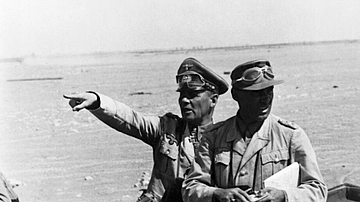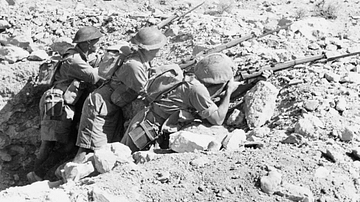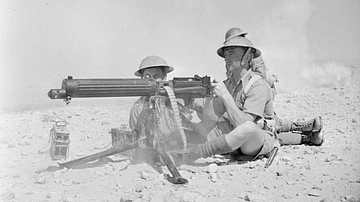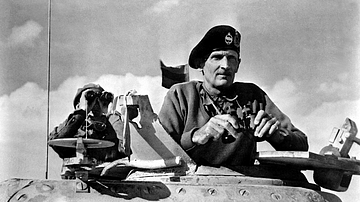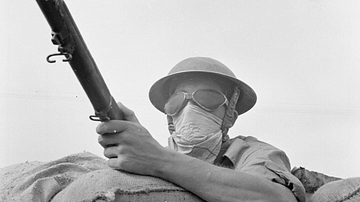
The Deutsches Afrika Korps (DAK) was an elite German armoured unit that fought in North Africa during the Second World War (1939-45). The Korps was initially led by Erwin Rommel (1891-1944) before he was promoted to lead a larger force of which the Korps remained a part. The Afrika Korps gained a reputation for its mastery of the desert environment, skill in arms, and esprit de corps.
Involved in the Western Desert Campaigns and the North Africa Campaign, the Afrika Korps was only one element of the Axis armies commanded by Rommel, but the term 'Afrika Korps' is commonly used to refer to all of Rommel's troops in Africa.
The Battle for North Africa
In 1940, an Italian army invaded British-held Egypt but was then pushed back across Libya in the Operation Compass offensive (December 1940 to February 1941). The Allies achieved an astonishing victory, capturing Tobruk and 138,000 prisoners, thanks to their superior weapons, armour, and tactics. The loss motivated the leader of Nazi Germany Adolf Hitler (1889-1945) to send to North Africa a better-trained and better-equipped force to meet the Allied threat. North Africa was important because whoever controlled it also controlled the Mediterranean shipping routes and islands like Crete and Malta. The Italian fascist leader Benito Mussolini (1883-1945), on the other hand, was keen to build himself a more impressive colonial empire on the continent. The Allies now had to face a combined Axis army. Hitler's orders for the German troops that arrived in February 1941 were to preoccupy and tie down as many Allied troops as possible, helping the Axis war effort elsewhere. Hitler was not looking for a campaign of conquest but one of containment that used up as few of his resources and as much of the enemy's as possible. Indeed, Hitler's name for the first German North African force was Sperrverband, meaning "special blocking detachment". The plan, known as Operation Sonnenblume (Sunflower), was to ensure the Italian forces in North Africa could continue to resist Allied offensives.
Formation & Structure
The Deutsches Afrika Korps, Hitler's new choice of name for his task force, was officially formed in February 1941. It was composed of two divisions: the 5th Light Division (renamed the 21st Panzer Division in October 1941) and the 15th Panzer Division. The divisions were formed from units from various sources, and none had desert experience.

Panzer divisions were the equivalent of Allied armoured divisions and included a greater proportion of tanks to infantry than a normal division. The 5th had 12,000 men and 160 tanks. The 15th had 15,000 men and 140 tanks. These were initial strengths, but the fully motorised Korps was expanded in the coming months with various Italian attachments added (for example, the Italian 'Savona' Division, one of six Italian divisions to be attached to the Afrika Korps during the war). There were, too, special temporary additions such as a parachute brigade. The Korps also included a number of specialised support units such as artillery and anti-tank batteries, a signals detachment, a Brandenburger commando/sabotage unit, a map unit, a water unit, a reconnaissance company, and a supplies battalion. In addition, the Korps received air support, both locally and from Italy, in the form of fighters like the Messerschmitt Bf 109 and the Junkers Ju 87 Stuka dive bomber. The German Luftwaffe (air force) also operated artillery units, which could be used as standard field artillery or in an anti-tank role.
The commander put in charge of the newly arrived German troops had very different ideas from Hitler on how to conduct the desert war. Erwin Rommel led the Afrika Korps from February to August 1941. Rommel, who had first gained fame for his command of the 7th Panzer Division during the Fall of France, preferred to attack the enemy whenever possible. Rommel also entertained ideas of pushing the Allies back into Egypt and even capturing the vital Suez Canal. Rommel gained such successes that he was given an enlarged army and then overall command of all Axis forces in the region. This army underwent several name changes: Panzer Group Africa (September 1941), Panzer Army Africa (January 1942), and the German-Italian Panzer Army (February 1943). The changes reflected the delicate political balancing act going on between Hitler and Mussolini. Although technically Rommel's superiors were the Italian high command (since Libya was an Italian colony), he often bypassed this level and communicated directly with Hitler, his relationship with the Nazi leader blossoming after each new victory.
Rommel quickly forged his divisions into formidable fighting units, largely through hard training and sheer personality. As one of Rommel's staff officers noted: "The Afrika Korps followed Rommel wherever he led, however hard he drove them" (Dear, 7).
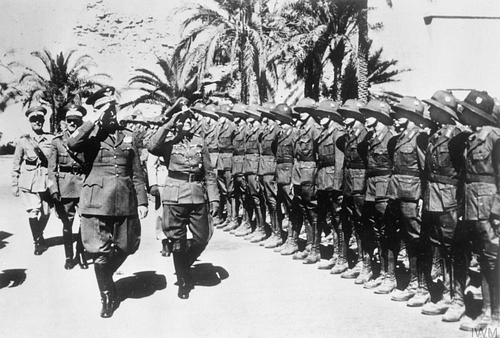
Commanders who succeeded Rommel as head of the Afrika Korps included General Ludwig Crüwell (sometimes spelt Cruewell, 1892-1958). In May 1942, when his plane was shot down in the desert, Crüwell was obliged to spend the remainder of the conflict as a prisoner of war. The confidence of the Afrika Korps is illustrated by Crüwell's remark upon being hosted in the Shepheard's Hotel, then Cairo's finest, that "it will make a grand headquarters for Rommel!" (Boatner, 110). Lieutenant-General Walther Nehring (1892-1983) took over from the unlucky Crüwell, although he was not immune to the Allied air force and was seriously wounded in an air raid in September 1942. The position of DAK commander was risky because the unit was always in the thick of the action. Another commander, Lieutenant-General Wilhelm Ritter von Thoma (1891-1948), was captured at El Alamein in November 1942 and held the dubious distinction of being the British Army's highest-ranking prisoner of war up to that point.
Whatever the name and size of the army Rommel commanded as he rose in the estimation of his superiors, the Afrika Korps always remained his most potent strike force, the first to form a spearhead when attacking and the first to be withdrawn when a defeat seemed likely. It was, then, no coincidence that the Korps' war cry was Heia Safari, Swahili for "Let's go get 'em" (Dear, 7).
Despite the heroics he achieved, often on a shoestring compared to his adversaries, Rommel would always struggle to gain the resources he wanted to conduct the campaign in his own way, especially after the German invasion of Russia (Operation Barbarossa) from June 1941, which became Hitler's priority. Dependent on men, machines, fuel, and supplies being shipped from Italy, these resources fluctuated wildly depending on how successful the Allies were in dominating the air and maintaining their almost total control of the Mediterranean Sea. As Rommel noted in his private letters, "Everything depends on supplies" (Strawson, 225).
Desert Warfare
The desert was a peculiar theatre of WWII. Here, the battles were intended to destroy the enemy's material and not to gain territory. There were few civilians involved outside the coastal areas, only the Senussi nomads, who tried to steer clear of these madmen and their machines of destruction. The desert is mostly flat, rock-strewn plains punctuated by occasional areas with more height such as an escarpment. The southern boundary was blocked to vehicles by natural features like salt marshes and the great sand dunes of the Sahara Desert. The flat terrain meant fighting was often conducted at a distance, and mobility was essential as armies swept here and there with their commanders, not always successfully, trying to keep track of where everyone was. There was certainly space to manoeuvre as generals dreamt up sweeping troop movements akin to admirals directing fleets at sea, but the downside was logistics since all supplies had to be transported along with the armies. As one German commander noted: "the desert was a tactician's paradise, but a quartermaster's nightmare" (Moreman, 9). The Afrika Korps were better than most in achieving total self-reliance and managing supplies; members even received letters from home with remarkable regularity.
The desert was a hostile environment, unbearably hot in the daytime and very often freezing at night. The hazards of raging sandstorms, scorpions, dysentery, and sores were matched by the milder irritations of flies and a monotonous diet of tinned food. Water was rationed to 3 litres per man per day in 1942. The Afrika Korps' well-sealed metal water can (also used to carry fuel) was much admired by Allied soldiers whose containers were inferior; this can became widely known as the 'jerrycan'.
DAK Uniforms
Officers often wore tropical breeches and a tunic of khaki brown or olive lightweight wool with a distinctive open collar and Afrika Korps cuffband. Higher-ranking officers frequently engaged a private tailor to make their uniforms, especially tunics which could then be adorned with badges from the standard Continental uniform.
The high laced boot or ankle boot version, borrowed from the German Army's tropical kit, were popular, as was the soft field cap with a long peak to shade the eyes, which became an identifying feature of Afrika Korps troops. It was a mark of a veteran to have a such a cap faded by the sun and so many soldiers bleached theirs so as not to stand out as inexperienced. Pith helmets saw some ceremonial use and sidecaps were preferred by tank crews.
Ordinary troops favoured shorts (not officially allowed in battle) and light cotton shirts for daytime and baggy trousers, wool sweaters, and brown double-breasted greatcoats of heavy wool for the cooler nights and early mornings. Captured enemy clothing was often worn, especially greatcoats. In battle, the standard steel helmet was used, although adapted for the desert by having it painted sand colour, with sand added to aid camouflage. Vehicles were similarly sand-coloured and carried the Afrika Korps logo of a palm tree and swastika.
Weapons
PzKpfw I, II, III, and IV tanks were used, the firepower and armour rising accordingly with the mark number. Most common was the mark III, which was fitted when possible with a 50mm gun. The mark IVs had a short 75mm gun, which was powerful but needed to be within a short range of the target to be effective against Allied armour; the firepower was eventually increased by adopting a longer barrel.
The Afrika Korps received a number of new Tiger tanks from December 1942, which had a brutal 88mm gun, armour four inches (10 cm) thick, and a better firing range than any Allied tank. Italian units deployed various types of Italian tanks such as the M13/40, but these were poorly armed and armoured, and often mechanically unreliable compared to German panzers. Fighting a battle inside any tank was far from pleasant with interior temperatures easily reaching 45 degrees Celsius (113 degrees Fahrenheit).
The DAK also employed numerous armoured and half-track vehicles which could act as reconnaissance and communication vehicles, troop carriers, or be used to pull artillery pieces. As a fully mobile army, the Afrika Korps had thousands of ordinary vehicles – trucks, ambulances, motorcycles, motorcycle sidecars, and cars. Many of these struggled to cope with the desert conditions they were not originally designed for, with sand ruining engines and the rough terrain proving merciless to suspension springs. Anywhere from one-third to two-thirds of a unit's vehicles could be out of action at any one time. It comes as no surprise then that by the summer of 1942, of all the Afrika Korps' vehicles, around half were captured from the enemy.
Anti-tank weapons included the 7.92mm Panzerbüchse 38 and 39 rifles, the 50mm Pak 38, and the innovative use of 88mm guns, which were originally designed as anti-aircraft weapons. An 88 could blast away at Allied tanks long before they came close enough to fire themselves. Other artillery pieces included the 75mm and 150mm Infanterie Geschütz.
Infantry were issued with a Karabiner 98k carbine, squad leaders had a 9mm Maschinenpistole 38 or 40 machine pistol, while senior officers carried a Walther P38 pistol. Heavier weapons included the 7.92mm Maschinengewehr 34 light machine gun and the 81mm Granatenwerfer 34 mortar. All weapons needed special care and attention in the desert to prevent sand blocking the mechanisms. Soldiers frequently wrapped the key parts in cloth, especially when subjected to the dust blown up from a moving vehicle or during a sandstorm.
Superior Tactics
A distinguishing feature of the Afrika Korps was its excellent use of combined arms: tanks, artillery, anti-tank units, and infantry. Rommel favoured speed and audacity, attacking in force using combined units to deeply penetrate the enemy lines at a specific point, cutting off units from their reserves and supplies, encircling the enemy, and then destroying material en masse. Meanwhile, Rommel's flanks were protected by reconnaissance forces, and the infantry behind the armour secured the ground just won. Heinz Schmidt, a panzer commander, explains how the plan of attack worked in practice:
We had developed a new method of attack. With our twelve anti-tank guns we leap-frogged from one vantage-point to another, while our Panzers, stationary and hull-down, if possible, provided protective fire. Then we would establish ourselves to give them protective fire while they swept on again. The tactics worked well and, despite the liveliness of the fire, the enemy's tanks were not able to hold up our advance. He steadily sustained losses and had to give ground constantly.
(Strawson, 117)
Although this aggressive approach often meant victories came at a high cost, these were tactics that greatly unsettled the much more cautious Allied commanders, officers who very often preferred to wait until they had an overwhelming advantage in men and material before making a decisive move on the enemy. It was not just speed and movement, though, that brought the Afrika Korps victories. Rommel proved time and again that anti-tank guns were far more effective against enemy tanks than tanks themselves, the traditional view of how tanks should be used. The Afrika Korps was also quick to innovate, such as using artillery weapons to fire horizontally at tanks. The Korps was also much better at recovering damaged vehicles from the battlefield than the Allies. In all then, "there was no doubt in anyone's mind that, even reduced to brigade strength, the veterans of the Afrika Korps formed the most powerful and formidable striking force in the desert" (Barr, 67)
The Allied equivalent of the Afrika Korps was the 7th Armoured Division ('Desert Rats') of the British Eighth Army, most successfully commanded by General Bernard Montgomery (1887-1976). Even this unit, though, was frequently outclassed by the efficiency, training, and battle experience of the Afrika Korps. Such were Rommel's successes that he became known to his enemies as the 'Desert Fox' in begrudging admiration. Indeed, the Allied high command became increasingly anxious that their soldiers were becoming bewitched with Rommel, who was seen by many as the bogeyman of the desert war, a general capable of extraordinary achievements in extraordinary places. The Nazi regime was keen to capitalise on this phenomenon, which also held true for Axis troops, and so Rommel was made a field marshal in 1942 in a glittering ceremony in Berlin that rivalled the Nuremberg rallies in pomp and show.
Campaigns
Victories where the Afrika Korps were heavily involved included the defeat of the Allies at El Agheila in March 1941 and then Mersa Brega on 1 April, capturing Benghazi on 4 April. The DAK then rebuffed the Allied offensives of Brevity and Battleaxe in May-June 1941, gained important victories at the Battle of Bir Hakeim and the Battle of Gazala (May to June 1942), which terminated with the capture of Tobruk, and it won a stunning victory at the Battle of Kasserine Pass in Tunisia (18-22 February 1943), which gave the US Army a first bloody taste of desert warfare.

Significant DAK losses included the failed siege of Tobruk (April to Dec 1941), the First Battle of El Alamein (July 1942), and the Second Battle of El Alamein (October to November 1942), when the tide definitively turned in the Allies' favour thanks to superior numbers of men, equipment, and supplies. Even as tens of thousands of their German and Italian colleagues were surrendering to the Allies, the Afrika Korps units were amongst the very last to raise the white flag. The Korps' last signal by its last commander, General Hans Cramer (1896-1968), read:
Ammunition shot off. Arms and equipment destroyed. In accordance with order received Afrika Korps has fought itself to the condition where it can fight no more. The German Afrika Korps must rise again. Heia Safari!.
(Dear, 7)
The Allied landings of Operation Torch in November 1942 and the attacks on Axis-held Tunisia gave the Allies their definitive victory in North Africa in May 1943. By then, Rommel had already returned to Germany due to ill health. The Desert Fox was not present to see the end of the Korps he had moulded into such a formidable fighting unit. Many of those Afrika Korps members taken prisoner of war in Tunisia were transported to distant Canada, where some would remain until 1947.






